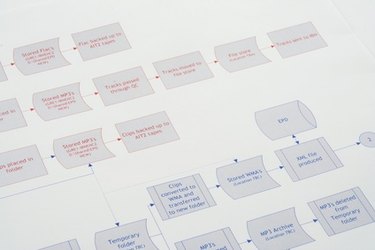
An As-Is Process Flow documents how a business process is performed currently in your organization. Typically an As-Is Process Flow is done to capture procedures and information that flow from step to step so that they can be analyzed and improved upon when you build a To-Be Process.
Step 1
Define the business process you want to analyze. It must be a complete business transaction with a start and finish, with inputs and outputs, and result in satisfying a business need. Example: "Hire Employee" is a complete process, whereas "Fill out hire form" is a step within the process, but it does not make sense if done alone.
Video of the Day
Step 2
Identify roles within the process. A role is a part that a person or group of people play in the process. The roles should be labeled with the type of action they take, not their jobs or department titles. A person who approves an employee's time card should be called "Time Approver."
Step 3
Identify process steps needed to complete the transaction. Capture each detailed step that adds value to the process, even if that value is only to review and ensure previous steps have been done correctly.
Step 4
Identify information passed from step to step within the process. Some steps create information to be used by subsequent steps.
Step 5
Identify decision points within the process that could change direction or require additional steps. Define the data needed to make the decision and account for all of the possible outcomes.
Step 6
Document the process flow by creating a diagram showing each step, the role that performs the step, and information flowing from step to step. Number each step. Define the direction of information by using arrows going from each step to the next. A "Cross-Functional" flow charting style works best to identify roles and flow of information between people as well as process steps. In the text portion of the document describe each step in detail.
Video of the Day